Temperature Prediction of Chinese Cities Based on GCN-BiLSTM
Abstract
:1. Introduction
- (1)
- We consider the spatial-temporal features of meteorological data and integrate the GCN-BiLSTM model to propose a novel temperature prediction method that improves the accuracy of temperature prediction from the perspective of temporal and spatial distribution.
- (2)
- The spatial relationship between the monitoring stations is used to learn the features of the meteorological data from the surrounding stations and to explore the correlation between the meteorological factors of the surrounding stations and the temperature of the target stations.
- (3)
- The research results show that the average RMSE of this prediction method is 2.671 °C and the average MAE is 3.024 °C for the future 14-day temperature prediction; for the multi-area temperature prediction, the average RMSE is 1.906 °C, and the average MAE is 2.583 °C. The model’s performance in this study is significantly better than other baseline models, and it has higher accuracy in cities with stable temperature fluctuations and small temperature differences.
2. Related Works
3. Materials and Methods
3.1. Data Source and Preprocessing
3.1.1. Data Source
3.1.2. Data Preprocessing
3.2. Methods
3.2.1. GCN Model
3.2.2. BiLSTM Model
3.2.3. GCN-BiLSTM Model
4. Results and Discussion
4.1. Experimental Data
4.2. Baseline Models
4.3. Evaluation Metrics
4.4. Results
4.4.1. 14-Day Temperature Prediction Experiment
4.4.2. Multi-Regional Temperature Prediction Experiment
4.5. Discussion
5. Conclusions
Author Contributions
Funding
Institutional Review Board Statement
Informed Consent Statement
Data Availability Statement
Conflicts of Interest
References
- Dyurgerov, M. Mountain and subpolar glaciers show an increase in sensitivity to climate warming and intensification of the water cycle. J. Hydrol. 2003, 282, 164–176. [Google Scholar] [CrossRef]
- WMO. Reducing and managing risks of disasters in a changing climate. WMO Bull. 2013, 62, 23–31. [Google Scholar]
- He, Y.; Zhang, Z.; Theakstone, W.H.; Chen, T.; Yao, T.; Pang, H. Changing features of the climate and glaciers in China’s monsoonal temperate glacier region. J. Geophys. Res.-Atmos. 2003, 108. [Google Scholar] [CrossRef]
- Tao, S.Y.; Zhao, S.X.; Zhou, X.P.; Ji, L.R.; Sun, S.Q.; Gao, S.T.; Zhang, Q.Y. Advances in weather science and weather forecasting. Atmos. Sci. 2003, 27, 451–467. [Google Scholar]
- Gustavo, Z.; Nuria, P.G.; Francisco, A.; Valdir, A.S.; Charlei, A. A Short Critical History on the Development of Meteorology and Climatology. Climate 2017, 5, 23. [Google Scholar]
- Bogdanovs, N.; Bistrovs, V.; Petersons, E.; Ipatovs, A.; Belinskis, R. Weather prediction algorithm based on historical data using kalman filter. In Proceedings of the 2018 Advances in Wireless and Optical Communications (RTUWO), Riga, Latvia, 15–16 November 2018; pp. 94–99. [Google Scholar]
- Pérez-Vega, A.; Travieso, M.C.; Hernández-Travieso, G.J.; Alonso, B.J.; Dutta, K.M.; Singh, A. Forecast of temperature using support vector machines. In Proceedings of the 2016 International Conference on Computing, Communication and Automation (ICCCA), Greater Noida, India, 29–30 April 2016; IEEE: New York, NY, USA, 2016; pp. 388–392. [Google Scholar]
- Liang, S.; Wang, D.; Wu, J.; Wang, R.; Wang, R. Method of Bidirectional LSTM Modelling for the Atmospheric Temperature. Intell. Autom. Soft Comput. 2021, 30, 701–714. [Google Scholar] [CrossRef]
- Federico, C.; Massimiliano, B. Wind speed and wind energy forecast through Kalman filtering of Numerical Weather Prediction model output. Appl. Energy 2012, 99, 154–166. [Google Scholar]
- Wang, H.; Huang, J.; Zhou, H.; Zhao, L.; Yuan, Y. An integrated variational mode decomposition and ARIMA model to forecast air temperature. Sustainability 2019, 11, 4018. [Google Scholar] [CrossRef] [Green Version]
- Kisi, O.; Cimen, M. Precipitation forecasting by using wavelet-support vector machine conjunction model. Eng. Appl. Artif. Intell. 2012, 25, 783–792. [Google Scholar] [CrossRef]
- Radhika, Y.; Shashi, M. Atmospheric temperature prediction using support vector machines. Int. J. Comput. Theory Eng. 2009, 1, 55. [Google Scholar] [CrossRef] [Green Version]
- Venkadesh, S.; Hoogenboom, G.; Potter, W.; McClendon, R. A genetic algorithm to refine input data selection for air temperature prediction using artificial neural networks. Appl. Soft Comput. 2013, 13, 2253–2260. [Google Scholar] [CrossRef]
- Abbot, J.; Marohasy, J. The application of machine learning for evaluating anthropogenic versus natural climate change. GeoResJ 2017, 14, 36–46. [Google Scholar] [CrossRef]
- Feng, H.C.; Xu, D.G. LSTM-based weather temperature prediction. Digit. Des. 2018, 7, 52. [Google Scholar]
- Wu, Y.; Wang, X. PM2. 5 concentration prediction using improved LSTM in big data environment. Fresenius Environ. Bull. 2020, 29, 10098–10108. [Google Scholar]
- Qiao, B.; Wu, Z.; Tang, Z.; Wu, G. Sea surface temperature prediction approach based on 3D CNN and LSTM with attention mechanism. In Proceedings of the 2022 24th International Conference on Advanced Communication Technology (ICACT), PyeongChang Kwangwoon_Do, Republic of Korea, 13–16 February 2022; IEEE: New York, NY, USA, 2022; pp. 342–347. [Google Scholar]
- Jeong, S.; Park, I.; Kim, H.; Song, C.; Kim, H. Temperature prediction based on bidirectional long short-term memory and convolutional neural network combining observed and numerical forecast data. Sensors 2021, 21, 941. [Google Scholar] [CrossRef]
- Cao, X.; Zhong, Y.; Zhou, Y.; Wang, J.; Zhu, C.; Zhang, W. Interactive temporal recurrent convolution network for traffic prediction in data centers. IEEE Access 2017, 6, 5276–5289. [Google Scholar] [CrossRef]
- Zhao, L.; Song, Y.; Zhang, C.; Liu, Y.; Wang, P.; Lin, T.; Deng, M.; Li, H. T-gcn: A temporal graph convolutional network for traffic prediction. IEEE Trans. Intell. Transp. Syst. 2019, 21, 3848–3858. [Google Scholar] [CrossRef] [Green Version]
- Meteorological Information Center. Daily Meteorological Dataset of Basic Meteorological Elements of China National Surface Weather Station (V3.0) (1951–2010); National Tibetan Plateau Data Center: Qinghai, China, 2019; Available online: http://data.cma.cn/ (accessed on 19 November 2022).
- Zhu, H.; Lin, Y.; Liu, Z.; Fu, J.; Chua, T.-S.; Sun, M. Graph Neural Networks with Generated Parameters for Relation Extraction. arXiv 2019, arXiv:1902.00756. [Google Scholar]
- Kipf, T.N.; Welling, M. Semi-Supervised Classification with Graph Convolutional Networks. arXiv 2016, arXiv:1609.02907. [Google Scholar]
- Shahani, N.M.; Kamran, M.; Zheng, X.; Liu, C. Predictive modeling of drilling rate index using machine learning approaches: LSTM, simple RNN, and RFA. Pet. Sci. Technol. 2022, 40, 534–555. [Google Scholar] [CrossRef]
- Kiperwasser, E.; Goldberg, Y. Simple and Accurate Dependency Parsing Using Bidirectional LSTM Feature Representations. Trans. Assoc. Comput. Linguist. 2016, 4, 313–327. [Google Scholar] [CrossRef]
- Li, L.; Yang, Y.; Yuan, Z.; Chen, Z. Spatial-temporal approach for traffic status analysis and prediction based on Bi-LSTM structure. Mod. Phys. Lett. B 2021, 35, 2150481. [Google Scholar] [CrossRef]
- Jian, L.; Zhao, Y.; Zhu, Y.-P.; Zhang, M.-B.; Bertolatti, D. An application of ARIMA model to predict submicron particle concentrations from meteorological factors at a busy roadside in Hangzhou, China. Sci. Total Environ. 2012, 426, 336–345. [Google Scholar] [CrossRef] [PubMed]
- Luc, S.; Frederic-Victor, D. Modelling progressive failure in fractured rock masses using a 3D discrete element method. Int. J. Rock Mech. Min. Sci. 2012, 52, 18–30. [Google Scholar]

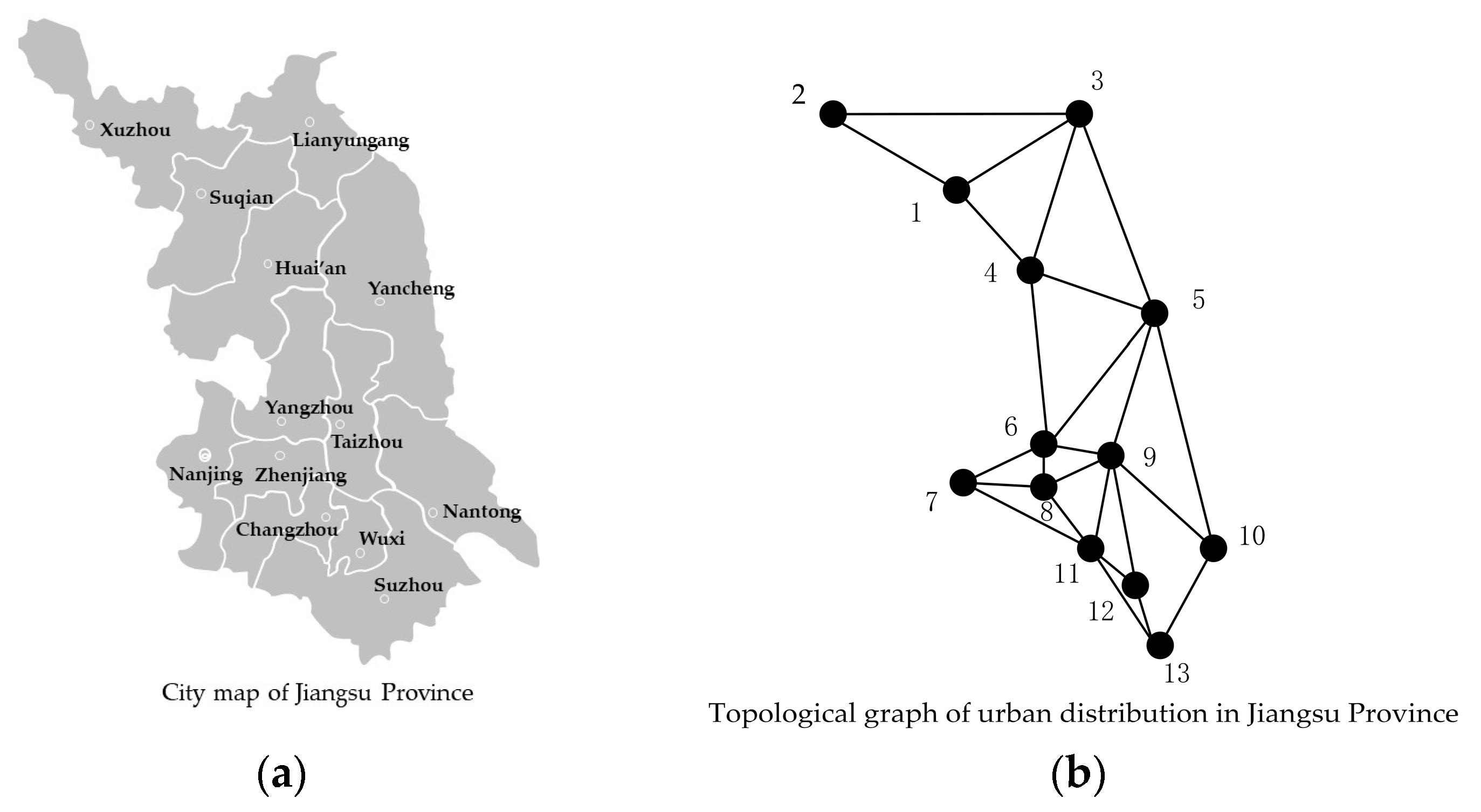

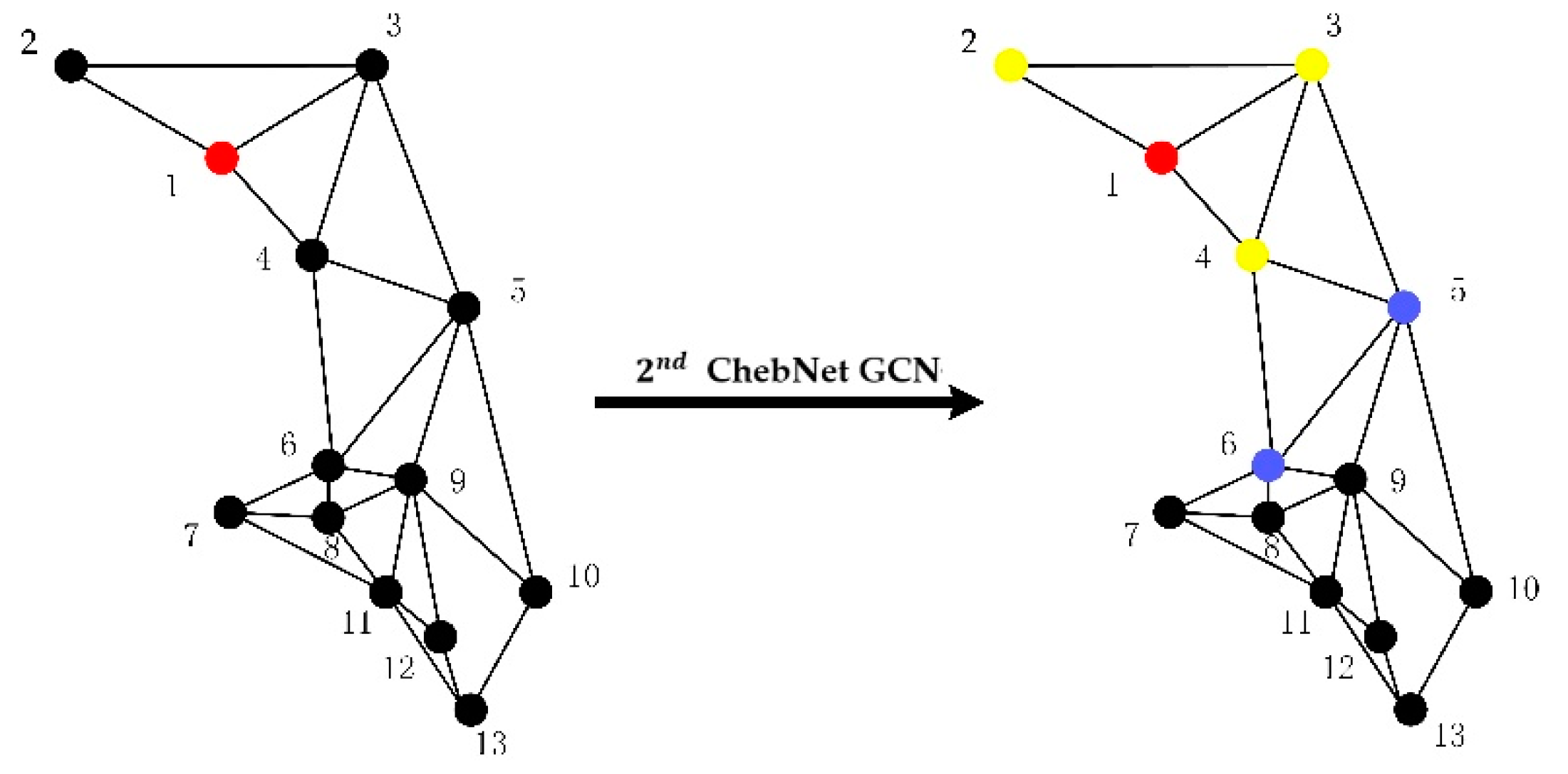
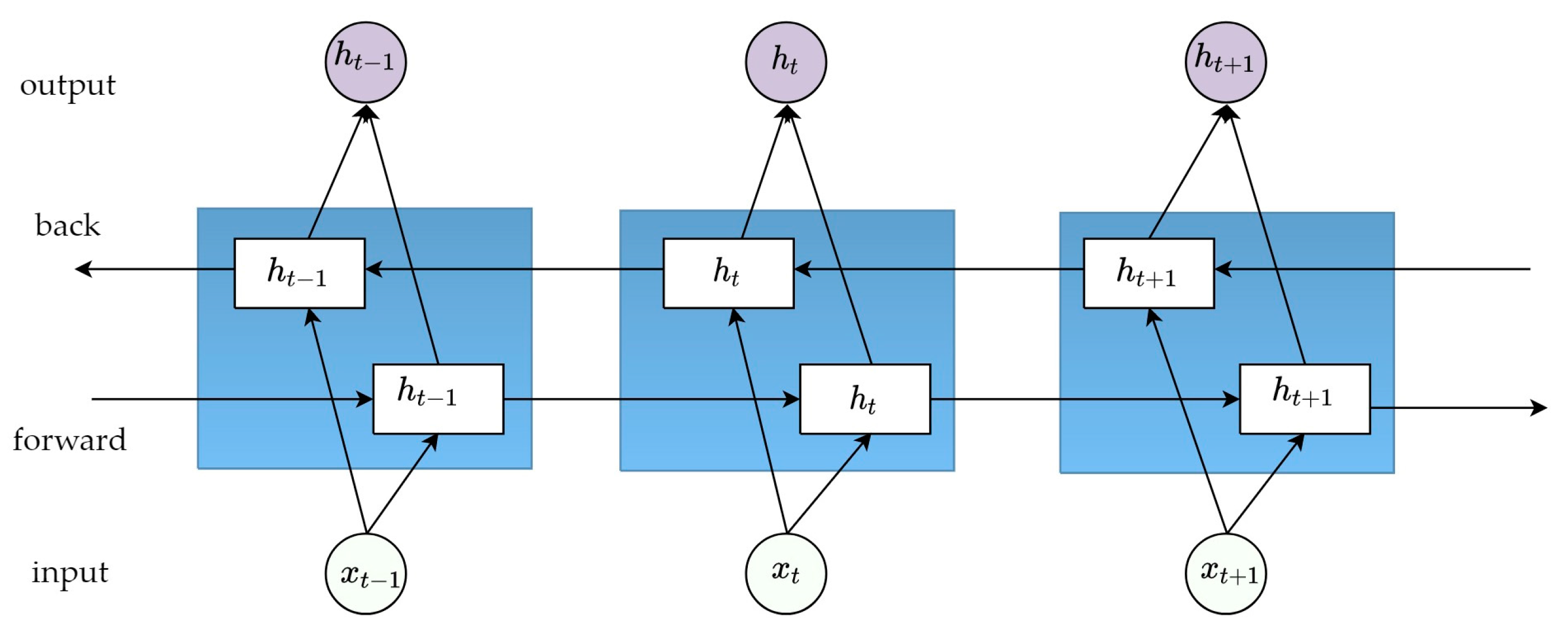

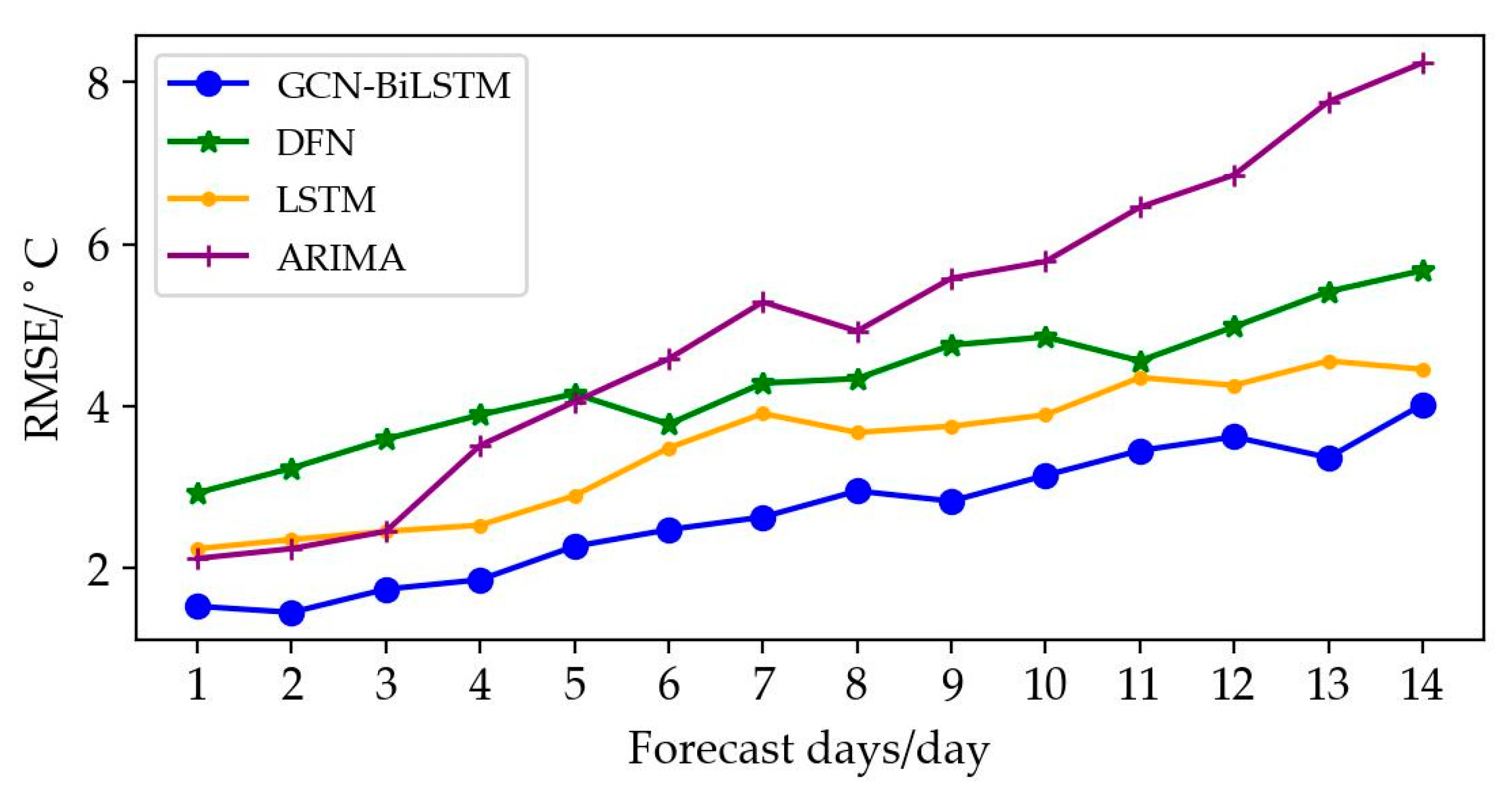
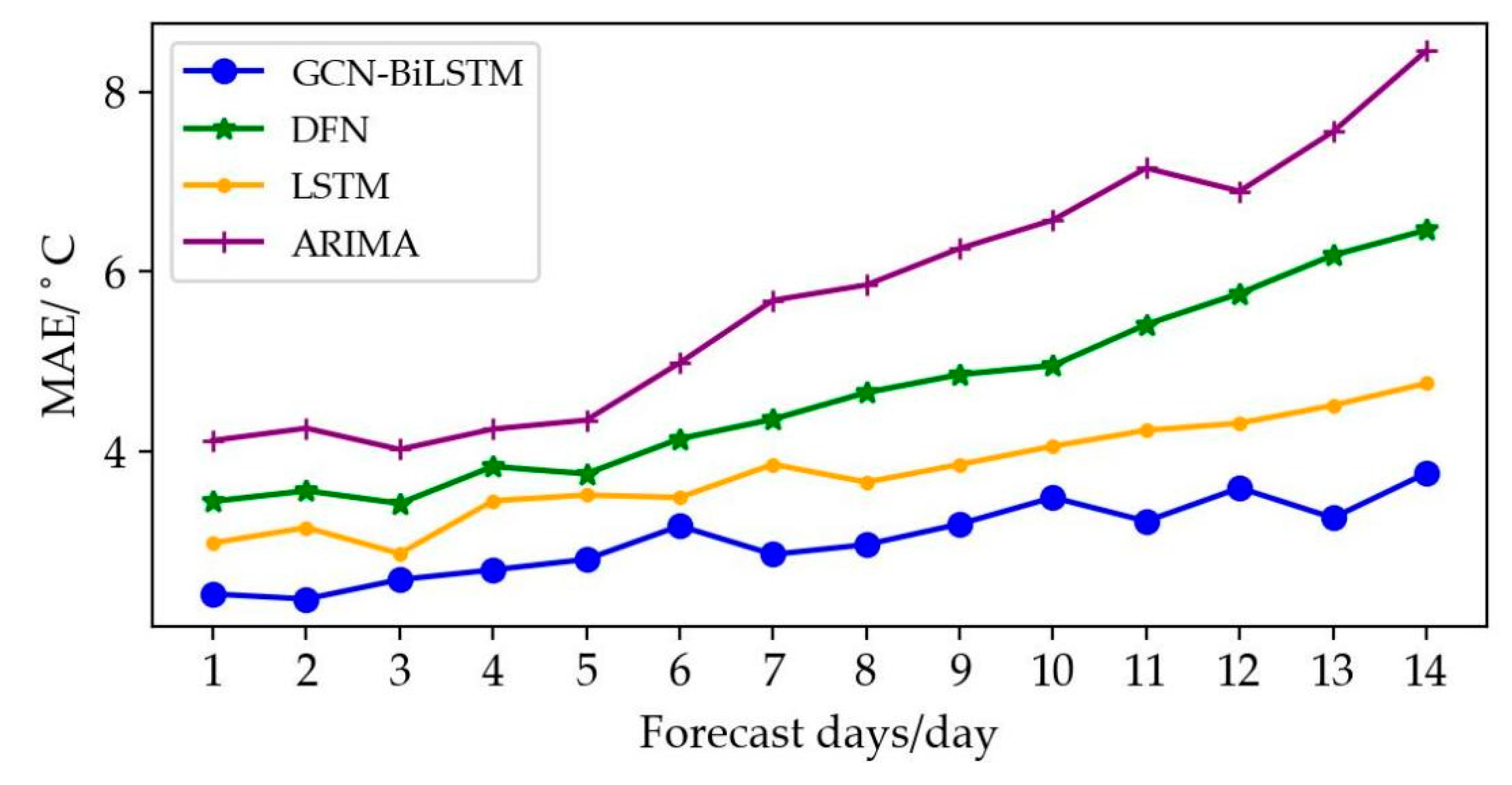
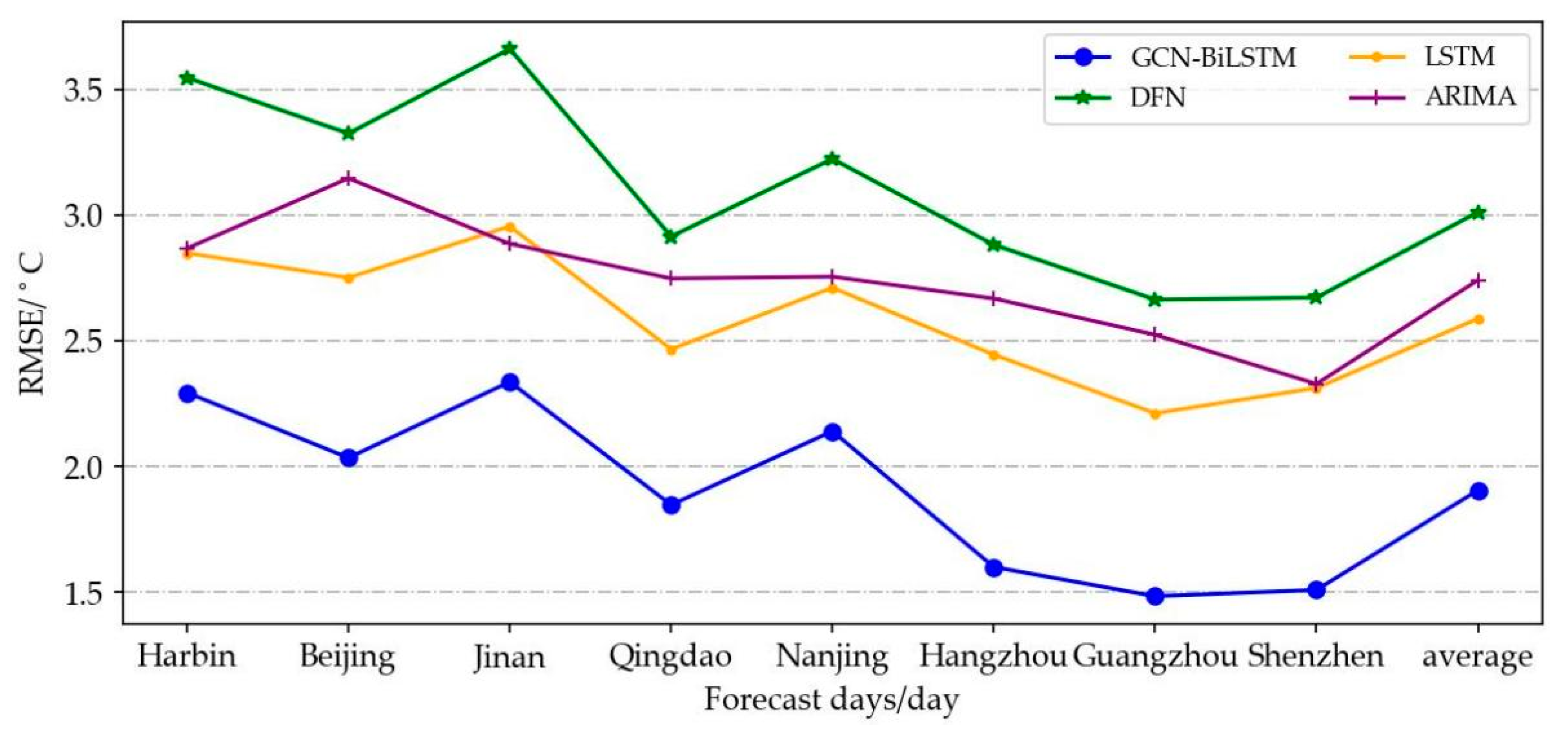
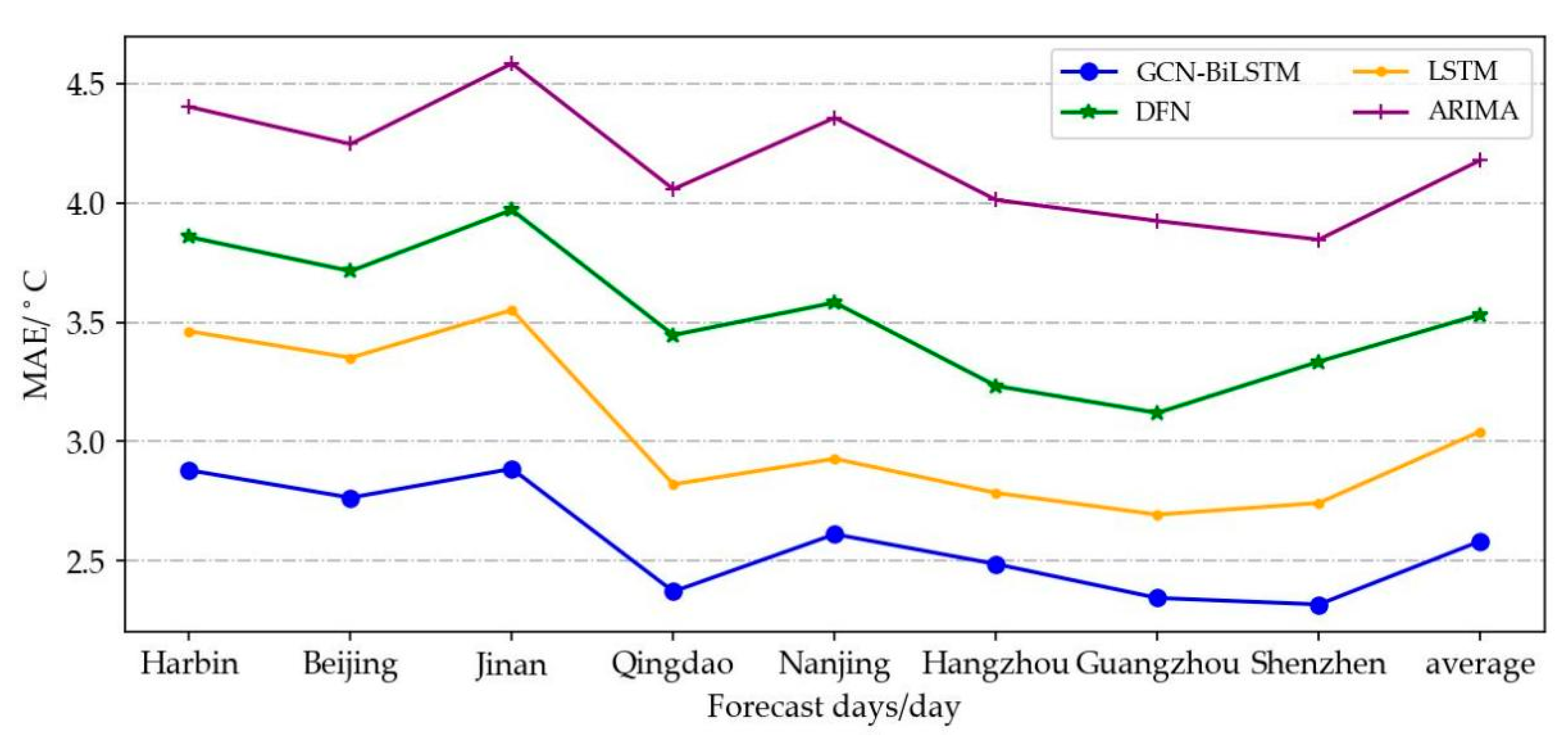
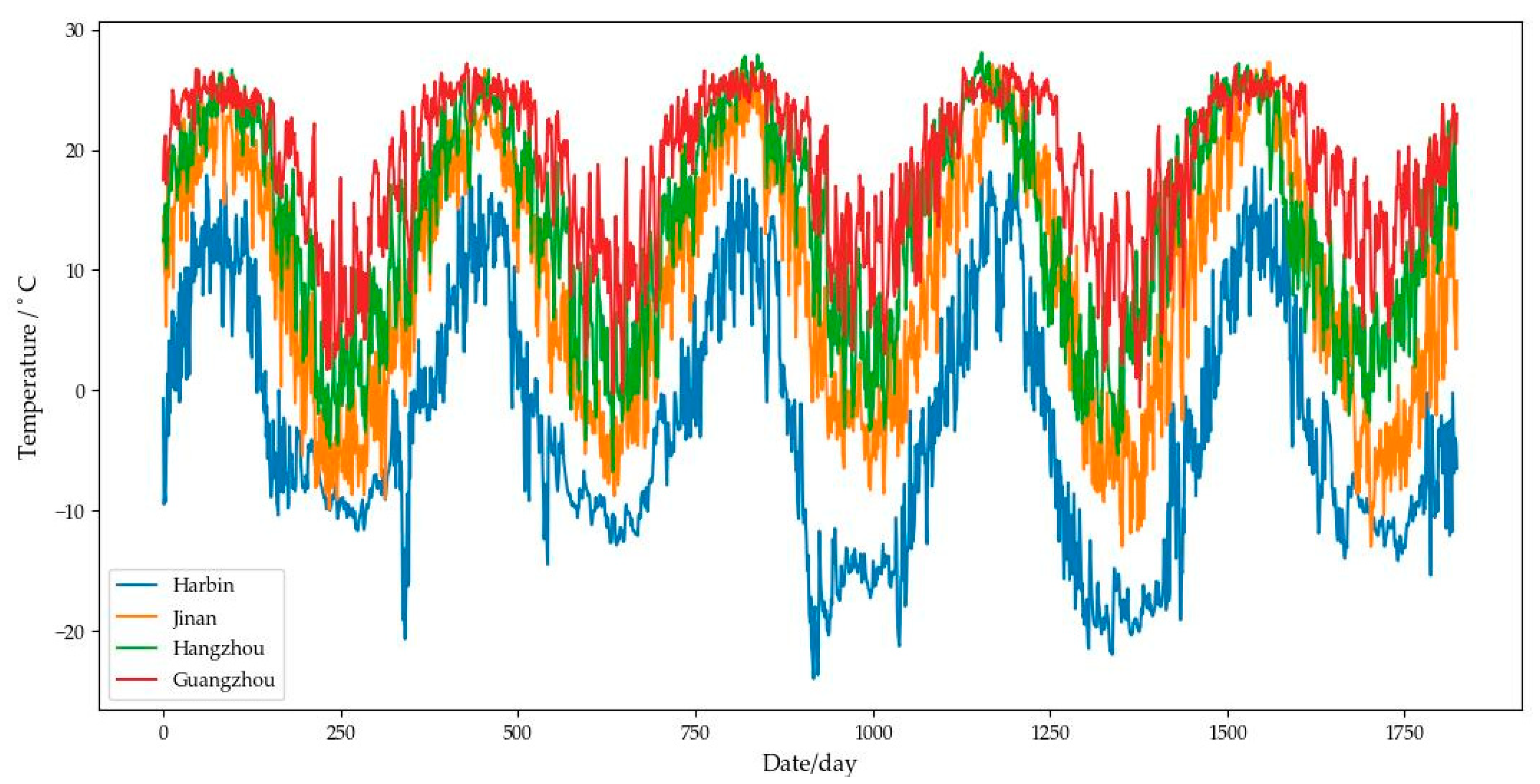
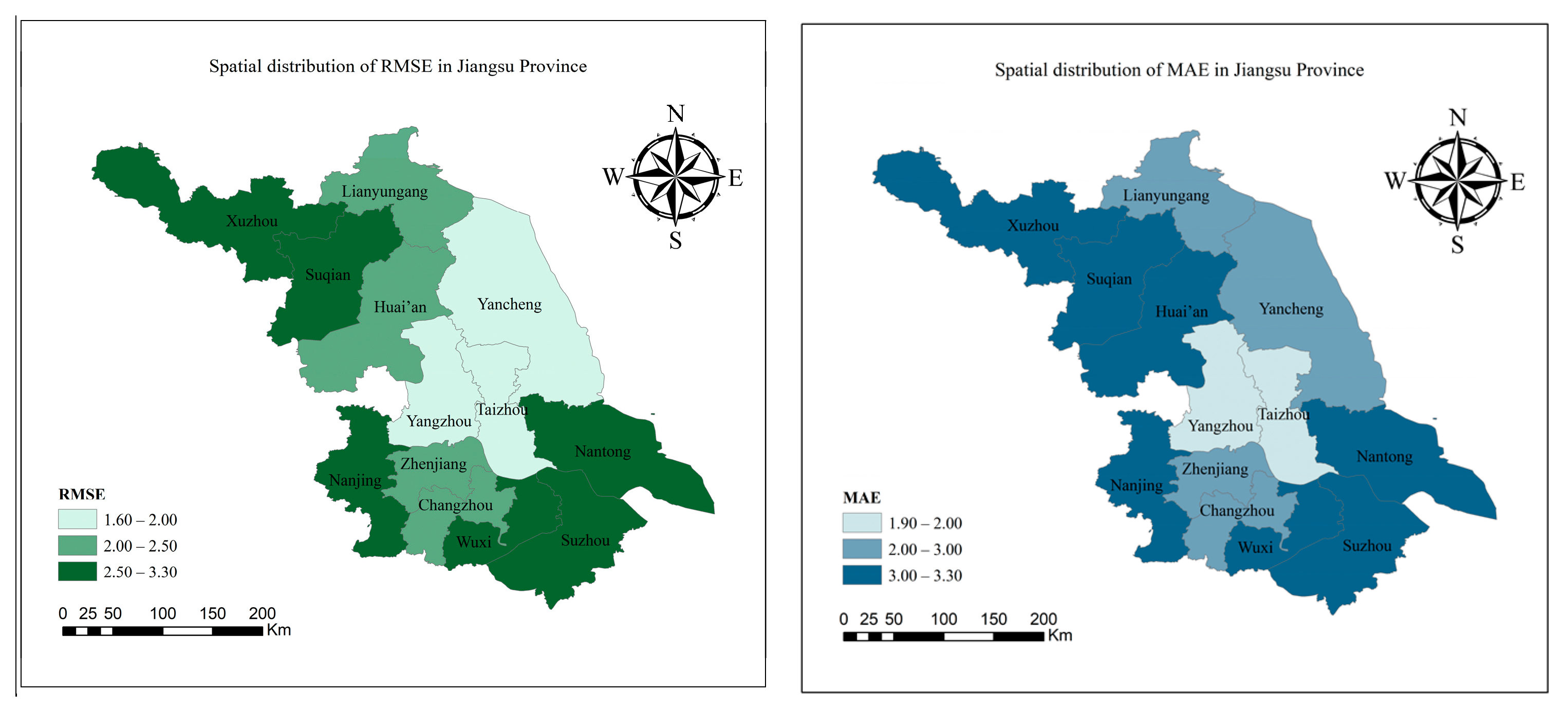
| Methods | Advantages | Disadvantages |
|---|---|---|
| Mathematical statistics (e.g., ARIMA) | Simple principle; fast calculation speed. | Single factor analysis; poor long-term predictive performance. |
| Machine learning methods (e.g., SVM) | Expertise in uncovering correlations between the factors. | Lack of analysis of time series. |
| Time series methods (e.g., LSTM) | Simple modeling; analysis of time series features. | Lack of analysis of spatial feature; low prediction accuracy when there are few time samples. |
| Spatial-temporal feature methods (e.g., CNN-BiLSTM) | Consider spatial-temporal characteristics; good at processing raster data and regular structure. | Poor performance in handling irregular graph structures |
| District Station | Date | Temperature (°C) | Relative Humidity (%) | Precipitation (0.1 mm) | Air Pressure (0.1 hPa) | … | Wind Speed (0.1 m/s) |
|---|---|---|---|---|---|---|---|
| 50136 | 1 May 2014 | 5.1 | 38 | 0 | 96,340 | … | 3.5 |
| 50136 | 2 May 2014 | 1.3 | 36 | 0 | 96,610 | … | 1.4 |
| 50136 | 3 May 2014 | 2.3 | 34 | 0 | 96,600 | … | 2.2 |
| 50136 | 4 May 2014 | 2.7 | 33 | 0 | 96,660 | … | 3 |
| 50136 | 5 May 2014 | 2.2 | 71 | 1.8 | 96,250 | … | 2.7 |
| 50136 | 6 May 2014 | 4.9 | 75 | 0 | 96,090 | … | 1.3 |
| Number | City | Number | City |
|---|---|---|---|
| 1 | Suqian | 8 | Zhenjiang |
| 2 | Xuzhou | 9 | Taizhou |
| 3 | Lianyungang | 10 | Nantong |
| 4 | Huai’an | 11 | Changzhou |
| 5 | Yancheng | 12 | Wuxi |
| 6 | Yangzhou | 13 | Suzhou |
| 7 | Nanjing |
| Number | 1 | 2 | 3 | 4 | 5 | 6 | 7 | 8 | 9 | 10 | 11 | 12 | 13 |
|---|---|---|---|---|---|---|---|---|---|---|---|---|---|
| 1 | 0 | 1 | 1 | 1 | 0 | 0 | 0 | 0 | 0 | 0 | 0 | 0 | 0 |
| 2 | 1 | 0 | 1 | 0 | 0 | 0 | 0 | 0 | 0 | 0 | 0 | 0 | 0 |
| 3 | 1 | 1 | 0 | 1 | 1 | 0 | 0 | 0 | 0 | 0 | 0 | 0 | 0 |
| 4 | 1 | 0 | 1 | 0 | 1 | 1 | 0 | 0 | 0 | 0 | 0 | 0 | 0 |
| 5 | 0 | 0 | 1 | 1 | 0 | 1 | 0 | 0 | 1 | 1 | 0 | 0 | 0 |
| 6 | 0 | 0 | 0 | 1 | 1 | 0 | 1 | 1 | 1 | 0 | 0 | 0 | 0 |
| 7 | 0 | 0 | 0 | 0 | 0 | 1 | 0 | 1 | 0 | 0 | 1 | 0 | 0 |
| 8 | 0 | 0 | 0 | 0 | 0 | 1 | 1 | 0 | 1 | 0 | 1 | 0 | 0 |
| 9 | 0 | 0 | 0 | 0 | 1 | 1 | 0 | 1 | 0 | 1 | 1 | 1 | 0 |
| 10 | 0 | 0 | 0 | 0 | 1 | 0 | 0 | 0 | 1 | 0 | 0 | 0 | 1 |
| 11 | 0 | 0 | 0 | 0 | 0 | 0 | 1 | 1 | 1 | 0 | 0 | 1 | 1 |
| 12 | 0 | 0 | 0 | 0 | 0 | 0 | 0 | 0 | 1 | 0 | 1 | 0 | 1 |
| 13 | 0 | 0 | 0 | 0 | 0 | 0 | 0 | 0 | 0 | 1 | 1 | 1 | 0 |
| Number | 1 | 2 | 3 | 4 | 5 | 6 | 7 | 8 | 9 | 10 | 11 | 12 | 13 |
|---|---|---|---|---|---|---|---|---|---|---|---|---|---|
| 1 | 3 | 0 | 0 | 0 | 0 | 0 | 0 | 0 | 0 | 0 | 0 | 0 | 0 |
| 2 | 0 | 2 | 0 | 0 | 0 | 0 | 0 | 0 | 0 | 0 | 0 | 0 | 0 |
| 3 | 0 | 0 | 4 | 0 | 0 | 0 | 0 | 0 | 0 | 0 | 0 | 0 | 0 |
| 4 | 0 | 0 | 0 | 4 | 0 | 0 | 0 | 0 | 0 | 0 | 0 | 0 | 0 |
| 5 | 0 | 0 | 0 | 0 | 5 | 0 | 0 | 0 | 0 | 0 | 0 | 0 | 0 |
| 6 | 0 | 0 | 0 | 0 | 0 | 5 | 0 | 0 | 0 | 0 | 0 | 0 | 0 |
| 7 | 0 | 0 | 0 | 0 | 0 | 0 | 3 | 0 | 0 | 0 | 0 | 0 | 0 |
| 8 | 0 | 0 | 0 | 0 | 0 | 0 | 0 | 6 | 0 | 0 | 0 | 0 | 0 |
| 9 | 0 | 0 | 0 | 0 | 0 | 0 | 0 | 0 | 6 | 0 | 0 | 0 | 0 |
| 10 | 0 | 0 | 0 | 0 | 0 | 0 | 0 | 0 | 0 | 3 | 0 | 0 | 0 |
| 11 | 0 | 0 | 0 | 0 | 0 | 0 | 0 | 0 | 0 | 0 | 5 | 0 | 0 |
| 12 | 0 | 0 | 0 | 0 | 0 | 0 | 0 | 0 | 0 | 0 | 0 | 3 | 0 |
| 13 | 0 | 0 | 0 | 0 | 0 | 0 | 0 | 0 | 0 | 0 | 0 | 0 | 3 |
| Province | District Station Number | Station Name | Latitude (d m) | Longitude (d m) | Altitude of the Barometric Sensor (m) | Altitude of the Observation Site (m) |
|---|---|---|---|---|---|---|
| Jiangsu | 58238 | Nanjing | 3156 | 11,854 | 36.4 | 35.2 |
| Jiangsu | 58354 | Wuxi | 3137 | 12,021 | 4.1 | 3.2 |
| Jiangsu | 58027 | Xuzhou | 3417 | 11,709 | 42.0 | 41.2 |
| Jiangsu | 58342 | Changzhou | 3143 | 11,933 | 7.7 | 6.9 |
| Jiangsu | 58349 | Suzhou | 3125 | 12,034 | 8.9 | 8.0 |
| Jiangsu | 58259 | Nantong | 3205 | 12,059 | 4.6 | 4.8 |
| Jiangsu | 58044 | Lianyungang | 3432 | 11,914 | 4.7 | 4.7 |
| Jiangsu | 58141 | Huai’an | 3338 | 11,856 | 13.7 | 12.5 |
| Jiangsu | 58154 | Yancheng | 3326 | 12,012 | 6.8 | 2.5 |
| Jiangsu | 58245 | Yangzhou | 3225 | 11,925 | 14.7 | 9.9 |
| Jiangsu | 58341 | Zhenjiang | 3159 | 11,936 | 10.2 | 6.6 |
| Jiangsu | 58246 | Taizhou | 3233 | 12,000 | 3.4 | 2.6 |
| Jiangsu | 58131 | Suqian | 3358 | 11,813 | 26.0 | 25.0 |
| Forecast Days | RMSE/°C | MAE/°C | ||||||
|---|---|---|---|---|---|---|---|---|
| GCN-BiLSTM | DFN | LSTM | ARIMA | GCN-BiLSTM | DFN | LSTM | ARIMA | |
| 1 | 1.534 | 2.933 | 2.245 | 2.124 | 2.414 | 3.445 | 2.982 | 4.122 |
| 2 | 1.459 | 3.238 | 2.357 | 2.245 | 2.358 | 3.562 | 3.152 | 4.258 |
| 3 | 1.745 | 3.596 | 2.458 | 2.458 | 2.574 | 3.421 | 2.863 | 4.022 |
| 4 | 1.862 | 3.895 | 2.534 | 3.518 | 2.682 | 3.832 | 3.450 | 4.249 |
| 5 | 2.273 | 4.156 | 2.898 | 4.056 | 2.799 | 3.751 | 3.715 | 4.348 |
| 6 | 2.479 | 3.780 | 3.487 | 4.585 | 3.171 | 4.141 | 3.887 | 4.985 |
| 7 | 2.635 | 4.286 | 3.911 | 5.287 | 2.854 | 4.358 | 3.956 | 5.681 |
| 8 | 2.956 | 4.342 | 3.678 | 4.928 | 2.963 | 4.655 | 3.658 | 5.852 |
| 9 | 2.831 | 4.756 | 3.756 | 5.580 | 3.192 | 4.855 | 4.254 | 6.258 |
| 10 | 3.149 | 4.856 | 3.895 | 5.787 | 3.487 | 4.956 | 4.058 | 6.574 |
| 11 | 3.455 | 4.560 | 4.355 | 6.456 | 3.223 | 5.412 | 4.535 | 7.152 |
| 12 | 3.624 | 4.981 | 4.259 | 6.854 | 3.594 | 5.758 | 4.914 | 6.895 |
| 13 | 3.368 | 5.415 | 4.560 | 7.758 | 3.261 | 6.182 | 5.112 | 7.556 |
| 14 | 4.023 | 5.676 | 4.457 | 8.236 | 3.758 | 5.962 | 5.457 | 8.457 |
| Average | 2.671 | 4.319 | 3.489 | 4.991 | 3.024 | 4.592 | 4.010 | 5.744 |
| City | GCN-BiLSTM | DFN | LSTM | ARIMA |
|---|---|---|---|---|
| Harbin | 2.294 | 3.546 | 2.849 | 2.868 |
| Beijing | 2.035 | 3.324 | 2.751 | 3.146 |
| Jinan | 2.337 | 3.660 | 2.955 | 2.886 |
| Qingdao | 1.848 | 2.915 | 2.467 | 2.748 |
| Nanjing | 2.141 | 3.223 | 2.711 | 2.755 |
| Hangzhou | 1.601 | 2.882 | 2.445 | 2.668 |
| Guangzhou | 1.485 | 2.664 | 2.212 | 2.524 |
| Shenzhen | 1.510 | 2.672 | 2.313 | 2.329 |
| average | 1.906 | 3.111 | 2.588 | 2.741 |
| City | GCN-BiLSTM | DFN | LSTM | ARIMA |
|---|---|---|---|---|
| Harbin | 2.880 | 3.857 | 3.462 | 4.402 |
| Beijing | 2.765 | 3.714 | 3.351 | 4.246 |
| Jinan | 2.886 | 3.970 | 3.551 | 4.583 |
| Qingdao | 2.372 | 3.446 | 2.821 | 4.057 |
| Nanjing | 2.612 | 3.582 | 2.928 | 4.356 |
| Hangzhou | 2.487 | 3.233 | 2.785 | 4.012 |
| Guangzhou | 2.345 | 3.120 | 2.694 | 3.924 |
| Shenzhen | 2.318 | 3.335 | 2.743 | 3.846 |
| average | 2.583 | 3.532 | 3.042 | 4.178 |
Publisher’s Note: MDPI stays neutral with regard to jurisdictional claims in published maps and institutional affiliations. |
© 2022 by the authors. Licensee MDPI, Basel, Switzerland. This article is an open access article distributed under the terms and conditions of the Creative Commons Attribution (CC BY) license (https://creativecommons.org/licenses/by/4.0/).
Share and Cite
Miao, L.; Yu, D.; Pang, Y.; Zhai, Y. Temperature Prediction of Chinese Cities Based on GCN-BiLSTM. Appl. Sci. 2022, 12, 11833. https://doi.org/10.3390/app122211833
Miao L, Yu D, Pang Y, Zhai Y. Temperature Prediction of Chinese Cities Based on GCN-BiLSTM. Applied Sciences. 2022; 12(22):11833. https://doi.org/10.3390/app122211833
Chicago/Turabian StyleMiao, Lizhi, Dingyu Yu, Yueyong Pang, and Yuehao Zhai. 2022. "Temperature Prediction of Chinese Cities Based on GCN-BiLSTM" Applied Sciences 12, no. 22: 11833. https://doi.org/10.3390/app122211833
APA StyleMiao, L., Yu, D., Pang, Y., & Zhai, Y. (2022). Temperature Prediction of Chinese Cities Based on GCN-BiLSTM. Applied Sciences, 12(22), 11833. https://doi.org/10.3390/app122211833






